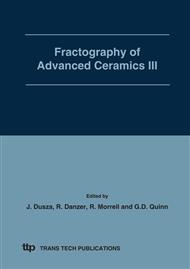p.216
p.223
p.231
p.237
p.244
p.252
p.260
p.267
p.275
Fracture of Oxide Matrix Composites with Different Phase Arrangement
Abstract:
The paper presents the analysis of the fracture path in composites with the alumina or zirconia matrix containing inclusions of another oxide or tungsten carbide. The description concerns the fracture of composite systems with 10 vol.% of inclusions (particulate composites), other three-systems with 33 vol.% of inclusions of each phase and the two phase composite with the equal phase content (50 : 50 vol.%). The different phase proportion and diversified content of inclusions cause significant differences in the microstructure of composites. The main difference between particulate composites and composites with continuous phases depends on a possibility of occurrence of toughening mechanisms connected with crack – inclusions interactions. In connection with a different interphase boundary strength, this phenomenon leads to significant differences in the way of composite fracture. The presented results of mechanical properties of composites were analyzed in the aspect of their way of fracture.
Info:
Periodical:
Pages:
244-251
Citation:
Online since:
March 2009
Authors:
Price:
Сopyright:
© 2009 Trans Tech Publications Ltd. All Rights Reserved
Share:
Citation:


